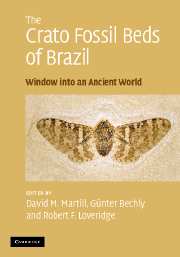Book contents
- Frontmatter
- Contents
- Contributors
- Preface
- Acknowledgements
- Part I The Crato Formation Konservat Lagerstätte
- Part II The invertebrate fauna
- Part III The vertebrate fauna
- 12 The Crato Formation fish fauna
- 13 Anurans of the Crato Formation
- 14 Turtles of the Crato Formation
- 15 Lizards of the Crato Formation
- 16 Crocodilians of the Crato Formation: evidence for enigmatic species
- 17 Pterosaurs of the Crato Formation
- 18 Birds of the Crato Formation
- Part IV The flora
- Part V Miscellanea
- Appendix: species list for the Crato Formation
- Systematic index
- Plate section
- References
18 - Birds of the Crato Formation
Published online by Cambridge University Press: 22 August 2009
- Frontmatter
- Contents
- Contributors
- Preface
- Acknowledgements
- Part I The Crato Formation Konservat Lagerstätte
- Part II The invertebrate fauna
- Part III The vertebrate fauna
- 12 The Crato Formation fish fauna
- 13 Anurans of the Crato Formation
- 14 Turtles of the Crato Formation
- 15 Lizards of the Crato Formation
- 16 Crocodilians of the Crato Formation: evidence for enigmatic species
- 17 Pterosaurs of the Crato Formation
- 18 Birds of the Crato Formation
- Part IV The flora
- Part V Miscellanea
- Appendix: species list for the Crato Formation
- Systematic index
- Plate section
- References
Summary
Introduction
Remains of possible birds are extremely rare in the Crato Formation and have so far only been reported from the Nova Olinda Member. The first report was of an isolated probable remex (Figure 18.1a) described by Martins-Neto and Kellner (1988), and subsequently refigured by Kellner et al. (1991) and Kellner (2002). Martill and Filgueira (1994) later described a semiplume, while Kellner et al. (1994) reported the occurrence of an isolated down feather. Several other feathers have since been reported from the Crato Formation (Kellner, 2002). Avian skeletal remains, although known from anecdotal accounts and personal observations, have yet to be reported in the literature and two examples are figured here for the first time (Plate 25d, Plate 26).
Isolated feathers occur in both the weathered, buff-coloured laminated limestone as goethite pseudomorphs, and as carbonaceous replicas in the unweathered limestones. Specimens preserved as carbonaceous replicas may be represented by bacterial autolithifications (Martill and Frey, 1995), and in this respect the preservation mirrors that of the famous soft-tissue fossils of the Eocene Messel Formation of Germany (Wuttke, 1983). As in the case of the Crato Formation insects, fine details may be preserved in the feathers, despite the bacterial autolithification. In some cases colour patterns appear to have been preserved; in most instances as dark and light transverse bands (Plate 25).
Although it has been possible to categorize these isolated feathers by comparison with modern feather morphotypes, it has not been possible to assign them to any particular taxon.
- Type
- Chapter
- Information
- The Crato Fossil Beds of BrazilWindow into an Ancient World, pp. 525 - 534Publisher: Cambridge University PressPrint publication year: 2007
References
- 6
- Cited by



